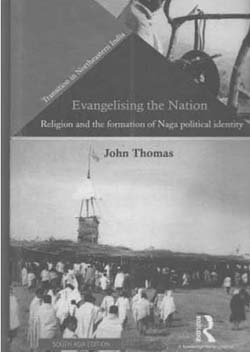Evangelising the Nation by John Thomas is an important study on the making of the Naga nation, and especially its relation with the (Baptist) Church. There are few works which have critically engaged with this relationship. The book covers the period from the late nineteenth century to the last decades of the twentieth century in five chapters.
Broadly, there are two inter-related processes which the book deals with. What is equally notable, as the book shows, is that the two processes emerged almost around the same time. One process was the making of the Naga nation, a political process of nationality formation among Nagas that could be concretely traced to the early twentieth century. In this regard, Thomas’s analysis appears to be based on one of the approaches applied in Indian historiography on the Freedom Movement. It is that nationalism need not be identified only in the language of nationalist representation of people but can be located in numerous articulations of nationhood. Thus, articulations of nationhood comprise a broader reality than the language per se of nationalism.
For example, it is through this approach that the book bridges the politics of the Naga Club or the Naga National Council (NNC) on the one hand and the Heraka movement on the other. Thus, the analysis shows that the political differences between the NNC and the Heraka movement was primarily a mystification of reality among Nagas rather than the reality itself. It was this mystification which resulted in the two forms of the same (Naga nationalist) ideological premise getting appropriated into two opposing politics in course of time, and in which the Nagas themselves participated. On what caused the mystification, the book suggests that both sides misrecognized the language of nationalism (or identity) as the other’s only self rather than perceiving the common context of nationhood, or the totality of the Naga self, that both in fact emerged from and stood for.
The other process that the book deals with is that of the rise of the (Baptist) Church as a powerful political mediator in the collective life of Nagas. The rise of the Church as one of the institutional mechanisms of Naga society could be traced to the early twentieth century. What was remarkable, as the book shows, was that this institutionalization of life became deep rooted. This was reflected in the fact that since the 1950s, when the American missionaries were forced by the Indian state to leave, the leadership and organizational role was quite successfully taken over by Nagas themselves. In this regard, a key point which the book reiterates, like a few other studies of the past, is that increasing adoption of Christianity needs to be located in the fundamental transformation of life which marked Naga society during the century, including that from violence since the 1940s. The process of conversion is explained from the perspective and experiences of the people rather than from that of the missionary discourse itself.
Herein the book also raises a significant issue, though not posed as such. It is that how one would understand this context of conversion on the one hand, and the institution of Church and its political role on the other. The question assumes importance because if the Church played a negative role or tried to subvert Naga nationhood politics, as the book argues, then how does one explain Nagas being entrapped in a fraught and contradictory condition of simultaneity between nationhood and religion, living both with equal fervour? The book seems to provide a two staged explanation. Namely, there was an ironical mystification of reality among Nagas in this regard, with an active role of the Indian state since the 1950s. The mystification may be read as caused by vicissitudes of the context.
Continue reading this review

